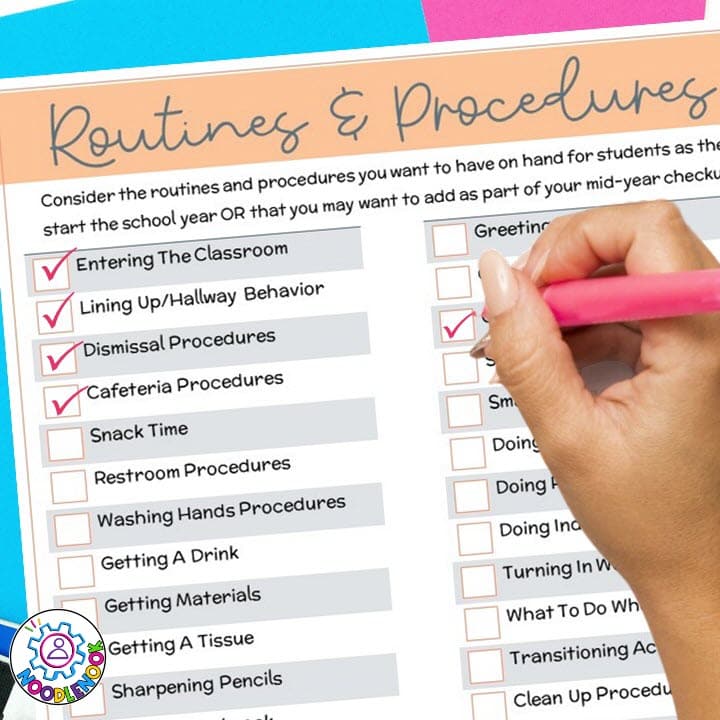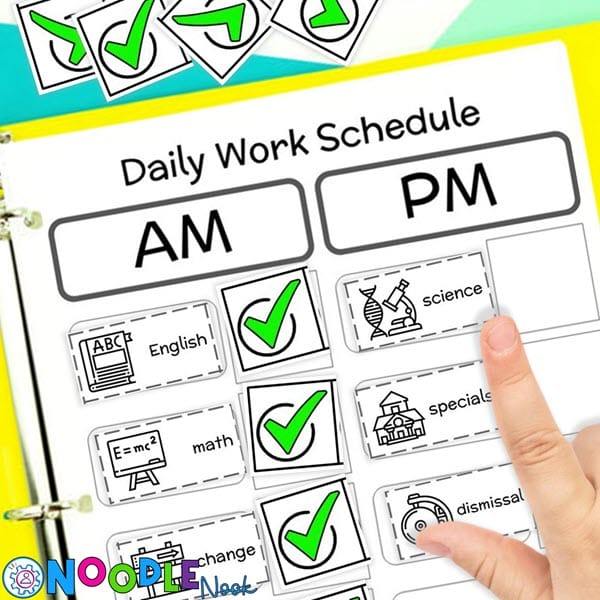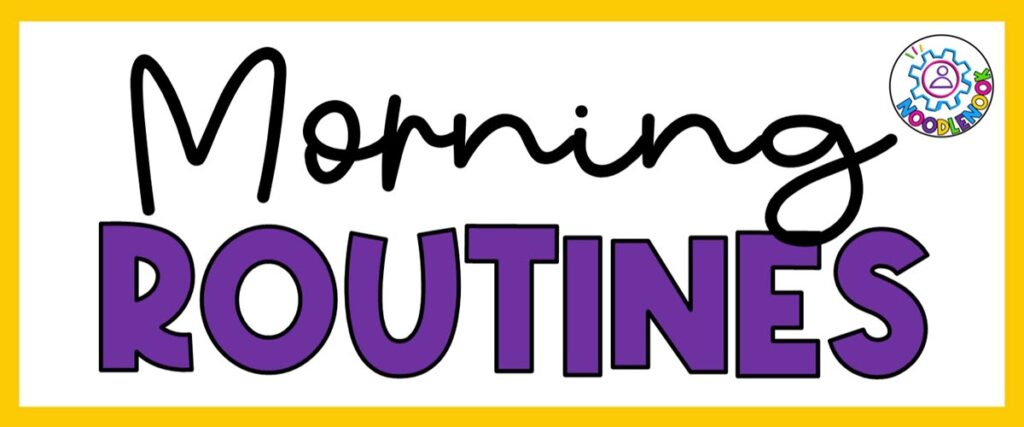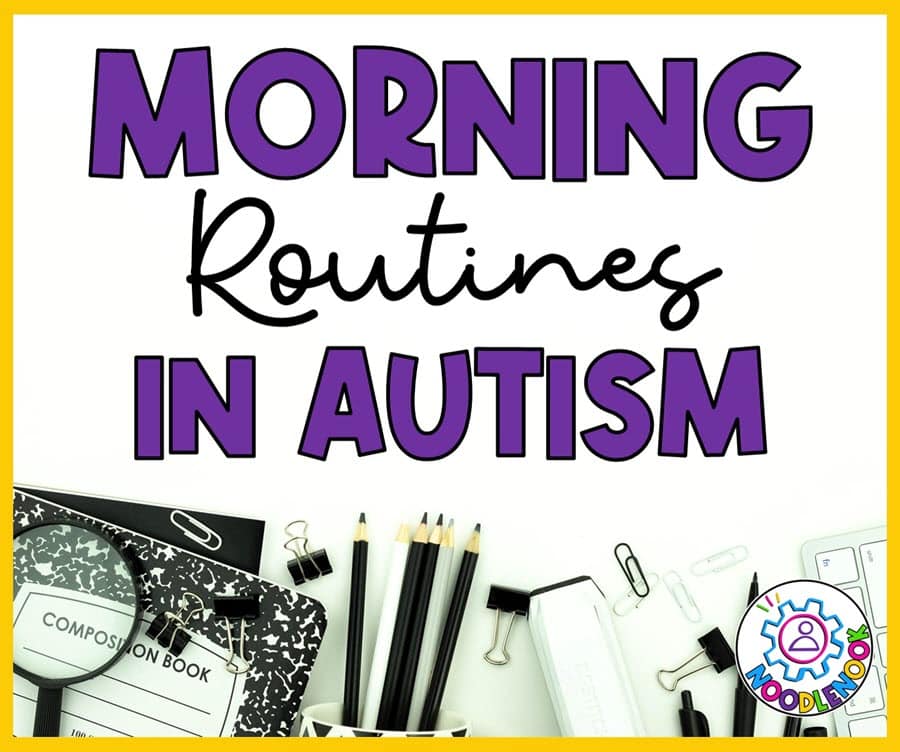We all have routines. I definitely have one. Before I even get into the classroom, I have a routine of things I do to get my day running right (read: grab a Coke, skip breakfast, and pretend to get through my lingering to-do list)… but I walk into classrooms all the time where students are sitting doing nothing as class starts. They are waiting in a permanent limbo for their teacher to start the class. Imagine if you got to your class earlier than usual- would you sit there waiting till ‘time’? Never. You would start your morning routine!
Do You Need a Morning Meeting?
Some classrooms have a morning meeting, some have circle time, and others have calendar time. No matter what you call it, the outcome is the same. You want to take a moment before the day or class begins to front-load what’s happening and hit on some basic skills including life skills, social skills, and communication skills.
Students with autism spectrum disorder (ASD), actually most students, operate better with a set school routines. Knowing the predictable rhythm of the day makes transitions easier, improves task completion, and helps you manage problem behavior before it happens (and isn’t that the best way?).
So, when it comes to morning routines in Autism classrooms, you might be asking yourself if you really need these morning meeting activities, the answer is YES!
I Don’t Have the Time to Meet

Yup, that is the number one objection I get. Some teachers only have a 45-55 minute class period to work with, like those of you in middle school and high school. The idea of ‘meeting’ seems like a waste of valuable minutes. It isn’t.
Even if you are only working with a single short class period, it’s still a good idea to do the morning meeting essentials listed below, just in a shorter time frame.
What you don’t have time for is disruptions and behaviors. That means making time for these routines. They support different students in multiple ways. Most profound is the ability to turn stressful mornings into a solid classroom morning routine free of meltdowns and tears (yours, not theirs).
Morning Meeting Essentials
Now that we have established the importance of a smooth morning routine, especially for autistic children, let’s dig deeper into an actual system. After all, a well-structured morning meeting is a key ingredient for success in a special education classroom. Here’s how to make yours a fantastic way to kickstart the school day:
1. Greet and Connect
Start with a friendly hello to each student, encouraging them to respond in their own way. This daily arrival ritual helps ease transitions and sets a positive tone for the day. You can use picture cards with greetings written on them, or even create a social story to help younger children understand this part of the routine so things go smoothly. If you have older students, have them use sign-in sheets (name recognition) or emotions check-in as their arrival greeting.
2. Warm-Up
Have an activity that students can do independently until it is time to start the next step. This is a short, solo task to keep students working (and occupied) while everyone arrives. No one should just be sitting doing nothing. Think folder games, grooming checklists, classroom chores, or anything they can manage on their own. Having something to do first thing sets the tone for your entire class or day. Just this “get to work” mindset is ‘small changes’ that have a huge impact. This can be a great time for ed assistants and staff members to do quick check-ins with students who might need extra support.
3. Do a Quick Share
As you get ready to start teaching, work a question of the day into your lesson plan. This quick morning activity isn’t a time suck. It’s a way to make sure all your students have a quality interaction before starting your lesson. It’s also a great way to target functional skills. Have students share something about their weekend, their evening, or their morning. Now, you may have just freaked out like “OMG, if all my students tell me about their day, it could take all week!” Yeah, it could! Don’t do that. Instead, have students share with a peer partner. This is perfect for older children to build communication skills and for young children to build social skills. Plus, on the academic front, you can prime prior knowledge with a quick share, like ‘tell what you know about storms’ or ‘share what you remember about yesterday’s lesson’. This question of the day is an important part of good instruction and should be part of your lesson plans.
4. Review the Schedule.

After you share, it’s time to check the schedule. And I would say that at several different times of the day. You want your students to be in the habit of looking ahead, which makes them better at following steps and builds independence.
Checking the schedule is THE key to your success.
You need a visual schedule in the classroom.
Visual supports and visual aids are the key to success in special education. Have students refer to the daily schedule and prepare them up front for the next activity or upcoming events. This doesn’t take too much time, but it’s a huge help for students with special needs. It’s also super helpful to put things up when you have unexpected changes to the routine.
5. Close the Meeting
End the meeting by letting students know where they’ll be transitioning next and what they’ll be learning today. This smooth segue sets them up perfectly for your station rotations, work systems, or learning centers. No matter what different activities you have up next, this new morning routine will make things run smoother, support student success, and make transitions So. Much. Easier!
6. Group Activity
Now that you’ve done your awesome morning time routine, you can get into your whole group activities. Your group activity may not be in a large group. You may have circle time and calendar time as two small group activities in an elementary classroom that you rotate. For secondary classrooms, your daily routine may skip a large whole group activity and hop right into independent work, centers, and stations with time limits for rotation. All of this works, but it’s made better by classroom routines, like the arrival routine.
Other Things to Consider
If you have made it this far into the post, I am sure you are 100% on board for taking some small steps towards a better-run autism classroom. There are just a couple more things to keep in mind:
If you’ve made it this far, you’re well on your way to creating a smoother-running autism classroom with a fantastic morning routine! Here are some additional things to keep in mind:
Also, remember the key pieces to meet individual student needs:
Starting YOUR Morning Routine
You have all the essentials for YOUR autism morning routine. Now, the objection lingering in your head is “How do I get this started?”
To start, you have to commit. You have to decide it WILL be a part of your classroom routine… even if you don’t have all the parts figured out. Start getting into the rhythm and then flush out the details as you go. A lot of the time you can figure out exactly what you need in the moment that you need it (and possibly not even think of it when you’re trying to preplan). Grab whatever classroom activity you already feel comfortable with and stick it in step 2 or 4 above. You can do this!
Also, having these items can help you implement a solid morning routine: Jumbo Dry Erase Classroom Calendar, Smaller- Desk Size Calendar, and don’t forget the dry erase markers!


